Icon College HND Business Project: Argos Equality and Diversity Impact
VerifiedAdded on 2023/01/10
|20
|4542
|20
Project
AI Summary
This business project examines the impact of equality and diversity practices on the recruitment, selection, and training strategies of Argos, a major UK retailer. The project includes a project management plan, work breakdown structure, and Gantt chart. It employs a qualitative research approach with a focus on interpretivism philosophy, utilizing both primary (questionnaire) and secondary data collection methods. Thematic data analysis is used to analyze employee responses regarding their awareness and understanding of equality and diversity, the impact on recruitment, and challenges faced. Recommendations are provided based on the findings, addressing challenges in integrating equality and diversity practices within Argos' recruitment and selection processes. The project also considers ethical considerations, validity, and reliability of the research.

MANAGING A
SUCCESSFUL BUSINESS
PROJECT
SUCCESSFUL BUSINESS
PROJECT
Paraphrase This Document
Need a fresh take? Get an instant paraphrase of this document with our AI Paraphraser
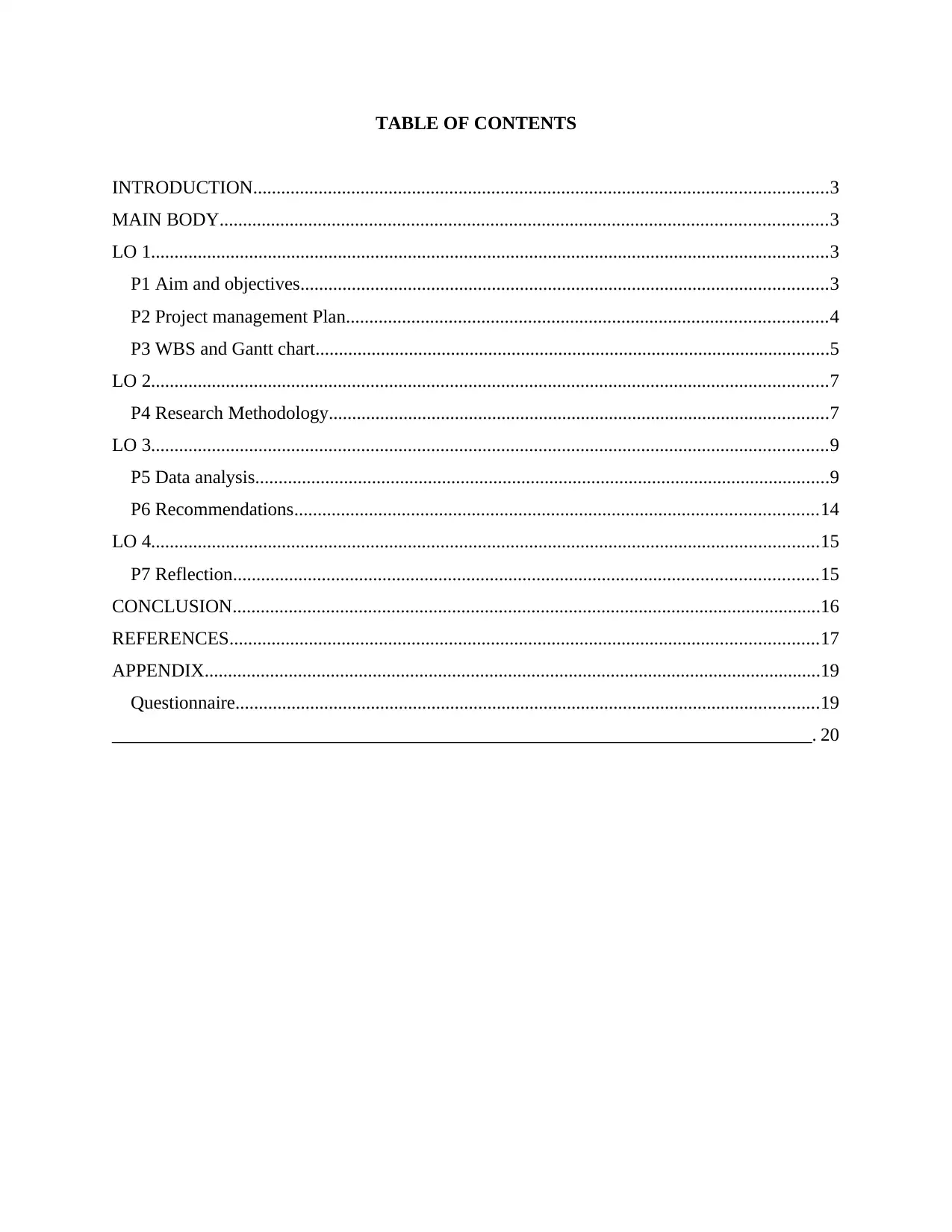
TABLE OF CONTENTS
INTRODUCTION...........................................................................................................................3
MAIN BODY..................................................................................................................................3
LO 1.................................................................................................................................................3
P1 Aim and objectives.................................................................................................................3
P2 Project management Plan.......................................................................................................4
P3 WBS and Gantt chart..............................................................................................................5
LO 2.................................................................................................................................................7
P4 Research Methodology...........................................................................................................7
LO 3.................................................................................................................................................9
P5 Data analysis...........................................................................................................................9
P6 Recommendations................................................................................................................14
LO 4...............................................................................................................................................15
P7 Reflection.............................................................................................................................15
CONCLUSION..............................................................................................................................16
REFERENCES..............................................................................................................................17
APPENDIX....................................................................................................................................19
Questionnaire.............................................................................................................................19
___________________________________________________________________________. 20
INTRODUCTION...........................................................................................................................3
MAIN BODY..................................................................................................................................3
LO 1.................................................................................................................................................3
P1 Aim and objectives.................................................................................................................3
P2 Project management Plan.......................................................................................................4
P3 WBS and Gantt chart..............................................................................................................5
LO 2.................................................................................................................................................7
P4 Research Methodology...........................................................................................................7
LO 3.................................................................................................................................................9
P5 Data analysis...........................................................................................................................9
P6 Recommendations................................................................................................................14
LO 4...............................................................................................................................................15
P7 Reflection.............................................................................................................................15
CONCLUSION..............................................................................................................................16
REFERENCES..............................................................................................................................17
APPENDIX....................................................................................................................................19
Questionnaire.............................................................................................................................19
___________________________________________________________________________. 20
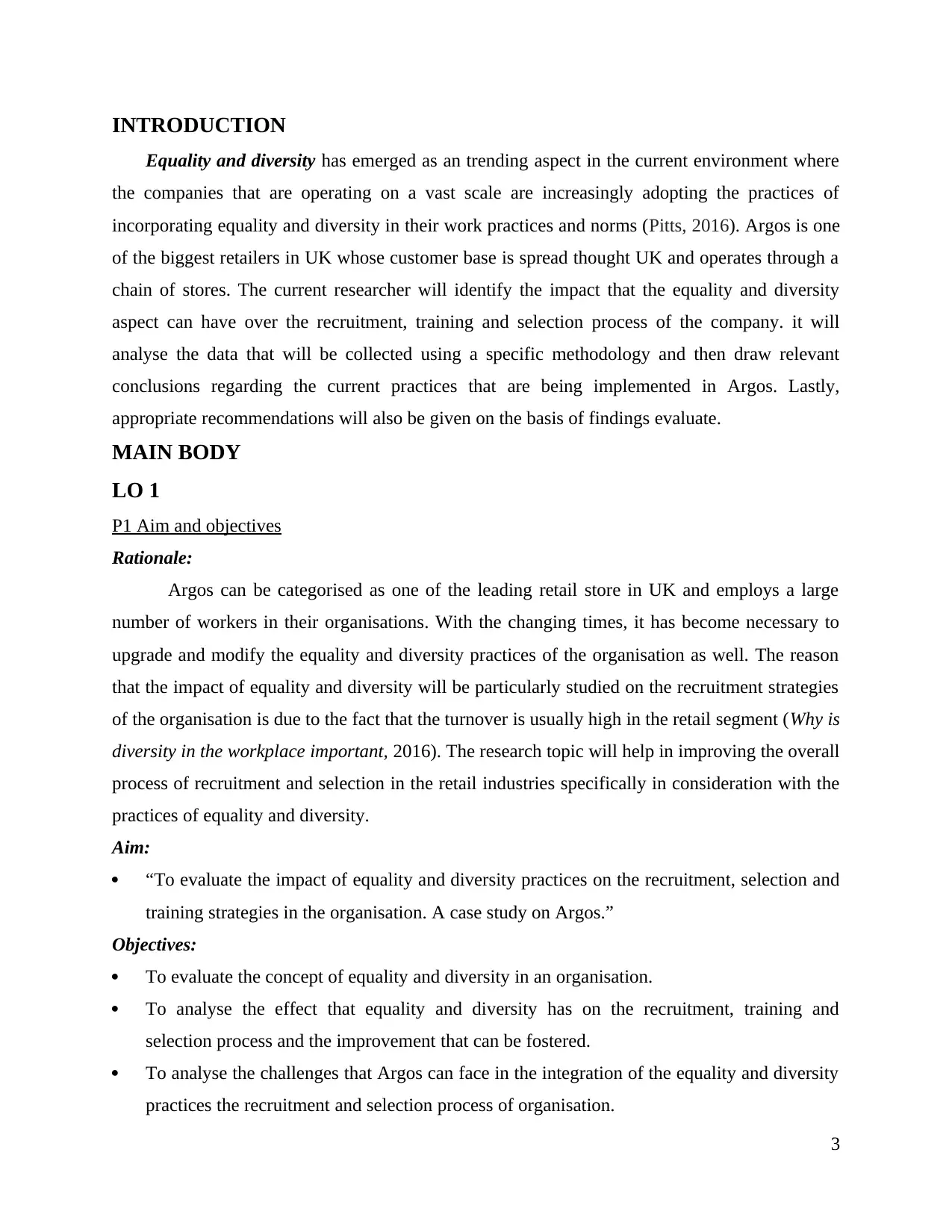
INTRODUCTION
Equality and diversity has emerged as an trending aspect in the current environment where
the companies that are operating on a vast scale are increasingly adopting the practices of
incorporating equality and diversity in their work practices and norms (Pitts, 2016). Argos is one
of the biggest retailers in UK whose customer base is spread thought UK and operates through a
chain of stores. The current researcher will identify the impact that the equality and diversity
aspect can have over the recruitment, training and selection process of the company. it will
analyse the data that will be collected using a specific methodology and then draw relevant
conclusions regarding the current practices that are being implemented in Argos. Lastly,
appropriate recommendations will also be given on the basis of findings evaluate.
MAIN BODY
LO 1
P1 Aim and objectives
Rationale:
Argos can be categorised as one of the leading retail store in UK and employs a large
number of workers in their organisations. With the changing times, it has become necessary to
upgrade and modify the equality and diversity practices of the organisation as well. The reason
that the impact of equality and diversity will be particularly studied on the recruitment strategies
of the organisation is due to the fact that the turnover is usually high in the retail segment (Why is
diversity in the workplace important, 2016). The research topic will help in improving the overall
process of recruitment and selection in the retail industries specifically in consideration with the
practices of equality and diversity.
Aim:
“To evaluate the impact of equality and diversity practices on the recruitment, selection and
training strategies in the organisation. A case study on Argos.”
Objectives:
To evaluate the concept of equality and diversity in an organisation.
To analyse the effect that equality and diversity has on the recruitment, training and
selection process and the improvement that can be fostered.
To analyse the challenges that Argos can face in the integration of the equality and diversity
practices the recruitment and selection process of organisation.
3
Equality and diversity has emerged as an trending aspect in the current environment where
the companies that are operating on a vast scale are increasingly adopting the practices of
incorporating equality and diversity in their work practices and norms (Pitts, 2016). Argos is one
of the biggest retailers in UK whose customer base is spread thought UK and operates through a
chain of stores. The current researcher will identify the impact that the equality and diversity
aspect can have over the recruitment, training and selection process of the company. it will
analyse the data that will be collected using a specific methodology and then draw relevant
conclusions regarding the current practices that are being implemented in Argos. Lastly,
appropriate recommendations will also be given on the basis of findings evaluate.
MAIN BODY
LO 1
P1 Aim and objectives
Rationale:
Argos can be categorised as one of the leading retail store in UK and employs a large
number of workers in their organisations. With the changing times, it has become necessary to
upgrade and modify the equality and diversity practices of the organisation as well. The reason
that the impact of equality and diversity will be particularly studied on the recruitment strategies
of the organisation is due to the fact that the turnover is usually high in the retail segment (Why is
diversity in the workplace important, 2016). The research topic will help in improving the overall
process of recruitment and selection in the retail industries specifically in consideration with the
practices of equality and diversity.
Aim:
“To evaluate the impact of equality and diversity practices on the recruitment, selection and
training strategies in the organisation. A case study on Argos.”
Objectives:
To evaluate the concept of equality and diversity in an organisation.
To analyse the effect that equality and diversity has on the recruitment, training and
selection process and the improvement that can be fostered.
To analyse the challenges that Argos can face in the integration of the equality and diversity
practices the recruitment and selection process of organisation.
3
⊘ This is a preview!⊘
Do you want full access?
Subscribe today to unlock all pages.

Trusted by 1+ million students worldwide
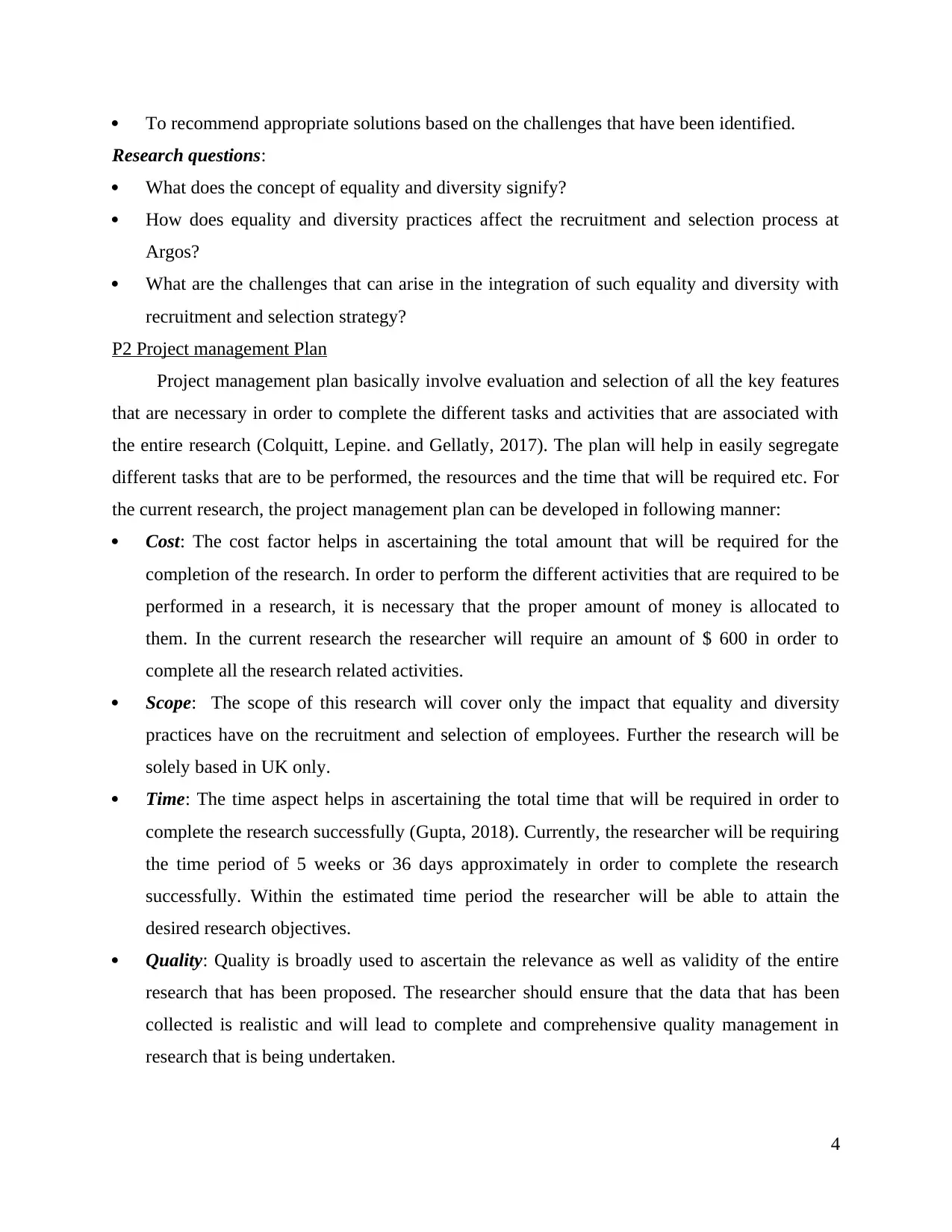
To recommend appropriate solutions based on the challenges that have been identified.
Research questions:
What does the concept of equality and diversity signify?
How does equality and diversity practices affect the recruitment and selection process at
Argos?
What are the challenges that can arise in the integration of such equality and diversity with
recruitment and selection strategy?
P2 Project management Plan
Project management plan basically involve evaluation and selection of all the key features
that are necessary in order to complete the different tasks and activities that are associated with
the entire research (Colquitt, Lepine. and Gellatly, 2017). The plan will help in easily segregate
different tasks that are to be performed, the resources and the time that will be required etc. For
the current research, the project management plan can be developed in following manner:
Cost: The cost factor helps in ascertaining the total amount that will be required for the
completion of the research. In order to perform the different activities that are required to be
performed in a research, it is necessary that the proper amount of money is allocated to
them. In the current research the researcher will require an amount of $ 600 in order to
complete all the research related activities.
Scope: The scope of this research will cover only the impact that equality and diversity
practices have on the recruitment and selection of employees. Further the research will be
solely based in UK only.
Time: The time aspect helps in ascertaining the total time that will be required in order to
complete the research successfully (Gupta, 2018). Currently, the researcher will be requiring
the time period of 5 weeks or 36 days approximately in order to complete the research
successfully. Within the estimated time period the researcher will be able to attain the
desired research objectives.
Quality: Quality is broadly used to ascertain the relevance as well as validity of the entire
research that has been proposed. The researcher should ensure that the data that has been
collected is realistic and will lead to complete and comprehensive quality management in
research that is being undertaken.
4
Research questions:
What does the concept of equality and diversity signify?
How does equality and diversity practices affect the recruitment and selection process at
Argos?
What are the challenges that can arise in the integration of such equality and diversity with
recruitment and selection strategy?
P2 Project management Plan
Project management plan basically involve evaluation and selection of all the key features
that are necessary in order to complete the different tasks and activities that are associated with
the entire research (Colquitt, Lepine. and Gellatly, 2017). The plan will help in easily segregate
different tasks that are to be performed, the resources and the time that will be required etc. For
the current research, the project management plan can be developed in following manner:
Cost: The cost factor helps in ascertaining the total amount that will be required for the
completion of the research. In order to perform the different activities that are required to be
performed in a research, it is necessary that the proper amount of money is allocated to
them. In the current research the researcher will require an amount of $ 600 in order to
complete all the research related activities.
Scope: The scope of this research will cover only the impact that equality and diversity
practices have on the recruitment and selection of employees. Further the research will be
solely based in UK only.
Time: The time aspect helps in ascertaining the total time that will be required in order to
complete the research successfully (Gupta, 2018). Currently, the researcher will be requiring
the time period of 5 weeks or 36 days approximately in order to complete the research
successfully. Within the estimated time period the researcher will be able to attain the
desired research objectives.
Quality: Quality is broadly used to ascertain the relevance as well as validity of the entire
research that has been proposed. The researcher should ensure that the data that has been
collected is realistic and will lead to complete and comprehensive quality management in
research that is being undertaken.
4
Paraphrase This Document
Need a fresh take? Get an instant paraphrase of this document with our AI Paraphraser
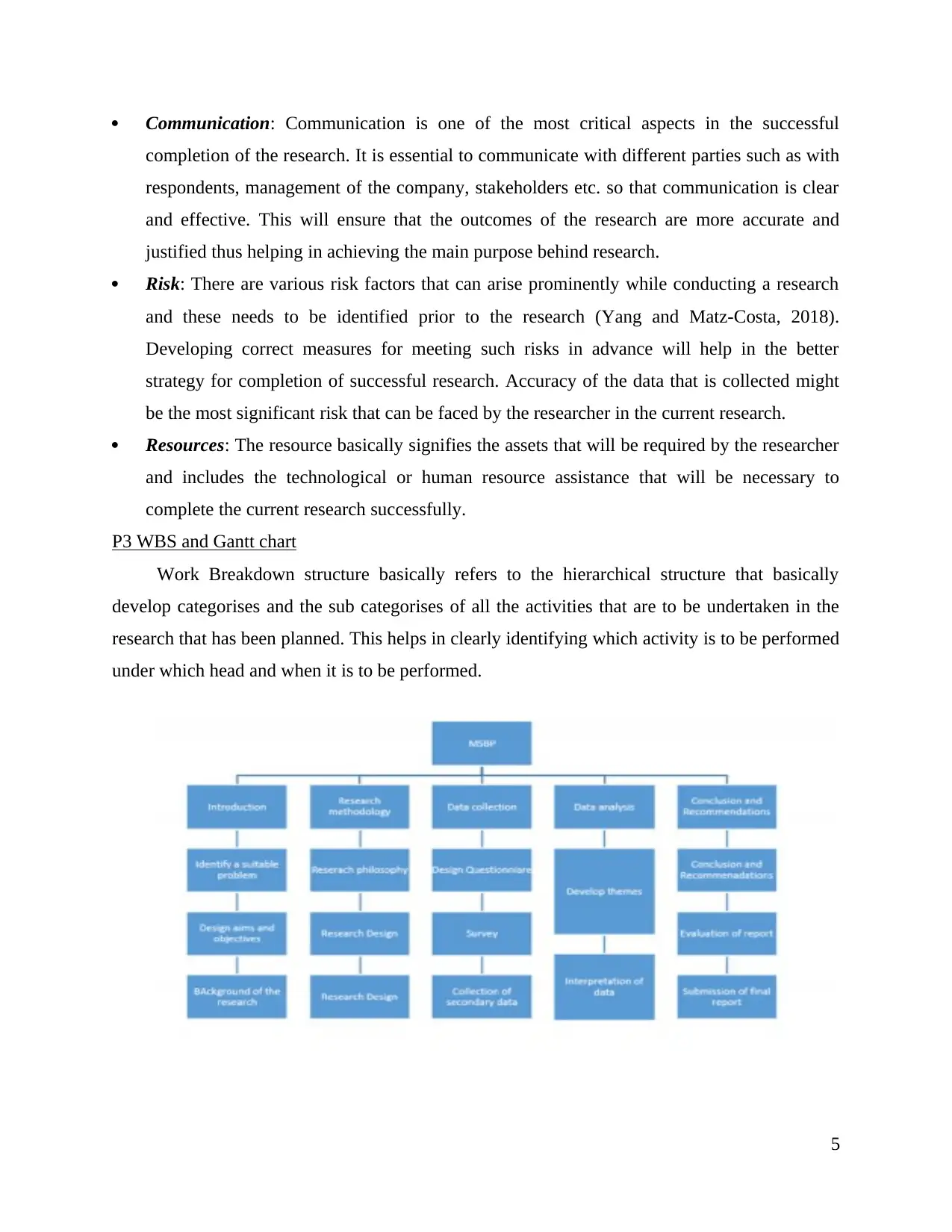
Communication: Communication is one of the most critical aspects in the successful
completion of the research. It is essential to communicate with different parties such as with
respondents, management of the company, stakeholders etc. so that communication is clear
and effective. This will ensure that the outcomes of the research are more accurate and
justified thus helping in achieving the main purpose behind research.
Risk: There are various risk factors that can arise prominently while conducting a research
and these needs to be identified prior to the research (Yang and Matz-Costa, 2018).
Developing correct measures for meeting such risks in advance will help in the better
strategy for completion of successful research. Accuracy of the data that is collected might
be the most significant risk that can be faced by the researcher in the current research.
Resources: The resource basically signifies the assets that will be required by the researcher
and includes the technological or human resource assistance that will be necessary to
complete the current research successfully.
P3 WBS and Gantt chart
Work Breakdown structure basically refers to the hierarchical structure that basically
develop categorises and the sub categorises of all the activities that are to be undertaken in the
research that has been planned. This helps in clearly identifying which activity is to be performed
under which head and when it is to be performed.
5
completion of the research. It is essential to communicate with different parties such as with
respondents, management of the company, stakeholders etc. so that communication is clear
and effective. This will ensure that the outcomes of the research are more accurate and
justified thus helping in achieving the main purpose behind research.
Risk: There are various risk factors that can arise prominently while conducting a research
and these needs to be identified prior to the research (Yang and Matz-Costa, 2018).
Developing correct measures for meeting such risks in advance will help in the better
strategy for completion of successful research. Accuracy of the data that is collected might
be the most significant risk that can be faced by the researcher in the current research.
Resources: The resource basically signifies the assets that will be required by the researcher
and includes the technological or human resource assistance that will be necessary to
complete the current research successfully.
P3 WBS and Gantt chart
Work Breakdown structure basically refers to the hierarchical structure that basically
develop categorises and the sub categorises of all the activities that are to be undertaken in the
research that has been planned. This helps in clearly identifying which activity is to be performed
under which head and when it is to be performed.
5
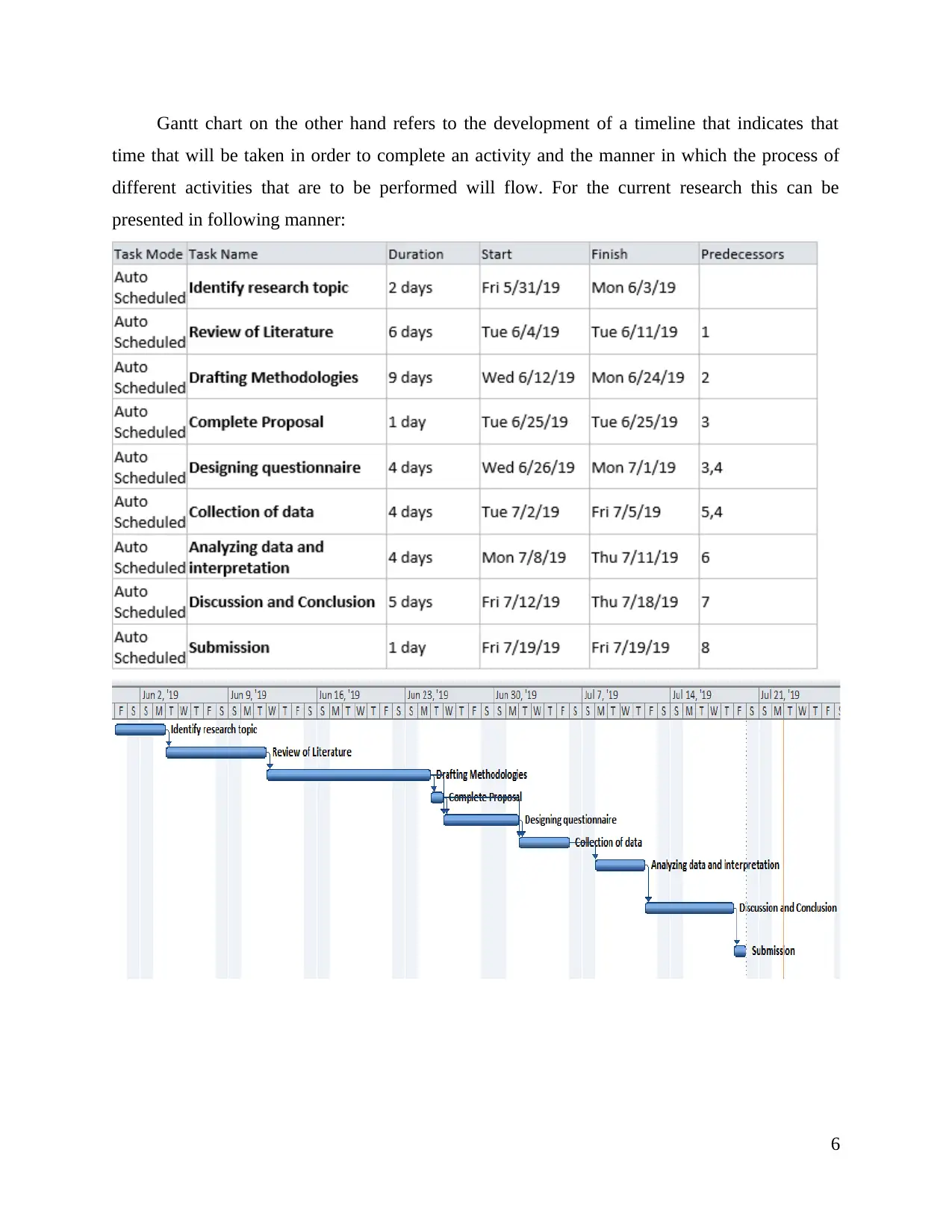
Gantt chart on the other hand refers to the development of a timeline that indicates that
time that will be taken in order to complete an activity and the manner in which the process of
different activities that are to be performed will flow. For the current research this can be
presented in following manner:
6
time that will be taken in order to complete an activity and the manner in which the process of
different activities that are to be performed will flow. For the current research this can be
presented in following manner:
6
⊘ This is a preview!⊘
Do you want full access?
Subscribe today to unlock all pages.

Trusted by 1+ million students worldwide
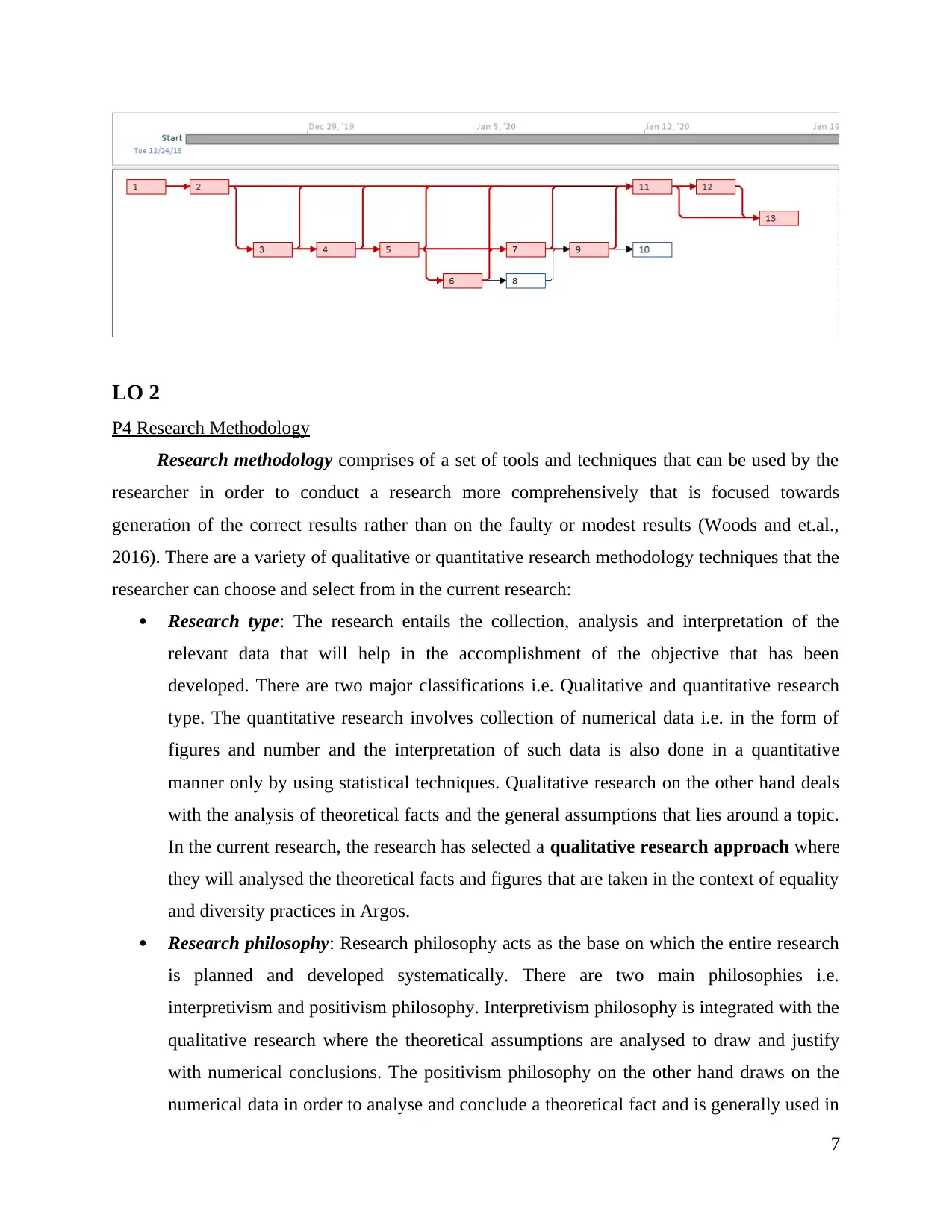
LO 2
P4 Research Methodology
Research methodology comprises of a set of tools and techniques that can be used by the
researcher in order to conduct a research more comprehensively that is focused towards
generation of the correct results rather than on the faulty or modest results (Woods and et.al.,
2016). There are a variety of qualitative or quantitative research methodology techniques that the
researcher can choose and select from in the current research:
Research type: The research entails the collection, analysis and interpretation of the
relevant data that will help in the accomplishment of the objective that has been
developed. There are two major classifications i.e. Qualitative and quantitative research
type. The quantitative research involves collection of numerical data i.e. in the form of
figures and number and the interpretation of such data is also done in a quantitative
manner only by using statistical techniques. Qualitative research on the other hand deals
with the analysis of theoretical facts and the general assumptions that lies around a topic.
In the current research, the research has selected a qualitative research approach where
they will analysed the theoretical facts and figures that are taken in the context of equality
and diversity practices in Argos.
Research philosophy: Research philosophy acts as the base on which the entire research
is planned and developed systematically. There are two main philosophies i.e.
interpretivism and positivism philosophy. Interpretivism philosophy is integrated with the
qualitative research where the theoretical assumptions are analysed to draw and justify
with numerical conclusions. The positivism philosophy on the other hand draws on the
numerical data in order to analyse and conclude a theoretical fact and is generally used in
7
P4 Research Methodology
Research methodology comprises of a set of tools and techniques that can be used by the
researcher in order to conduct a research more comprehensively that is focused towards
generation of the correct results rather than on the faulty or modest results (Woods and et.al.,
2016). There are a variety of qualitative or quantitative research methodology techniques that the
researcher can choose and select from in the current research:
Research type: The research entails the collection, analysis and interpretation of the
relevant data that will help in the accomplishment of the objective that has been
developed. There are two major classifications i.e. Qualitative and quantitative research
type. The quantitative research involves collection of numerical data i.e. in the form of
figures and number and the interpretation of such data is also done in a quantitative
manner only by using statistical techniques. Qualitative research on the other hand deals
with the analysis of theoretical facts and the general assumptions that lies around a topic.
In the current research, the research has selected a qualitative research approach where
they will analysed the theoretical facts and figures that are taken in the context of equality
and diversity practices in Argos.
Research philosophy: Research philosophy acts as the base on which the entire research
is planned and developed systematically. There are two main philosophies i.e.
interpretivism and positivism philosophy. Interpretivism philosophy is integrated with the
qualitative research where the theoretical assumptions are analysed to draw and justify
with numerical conclusions. The positivism philosophy on the other hand draws on the
numerical data in order to analyse and conclude a theoretical fact and is generally used in
7
Paraphrase This Document
Need a fresh take? Get an instant paraphrase of this document with our AI Paraphraser
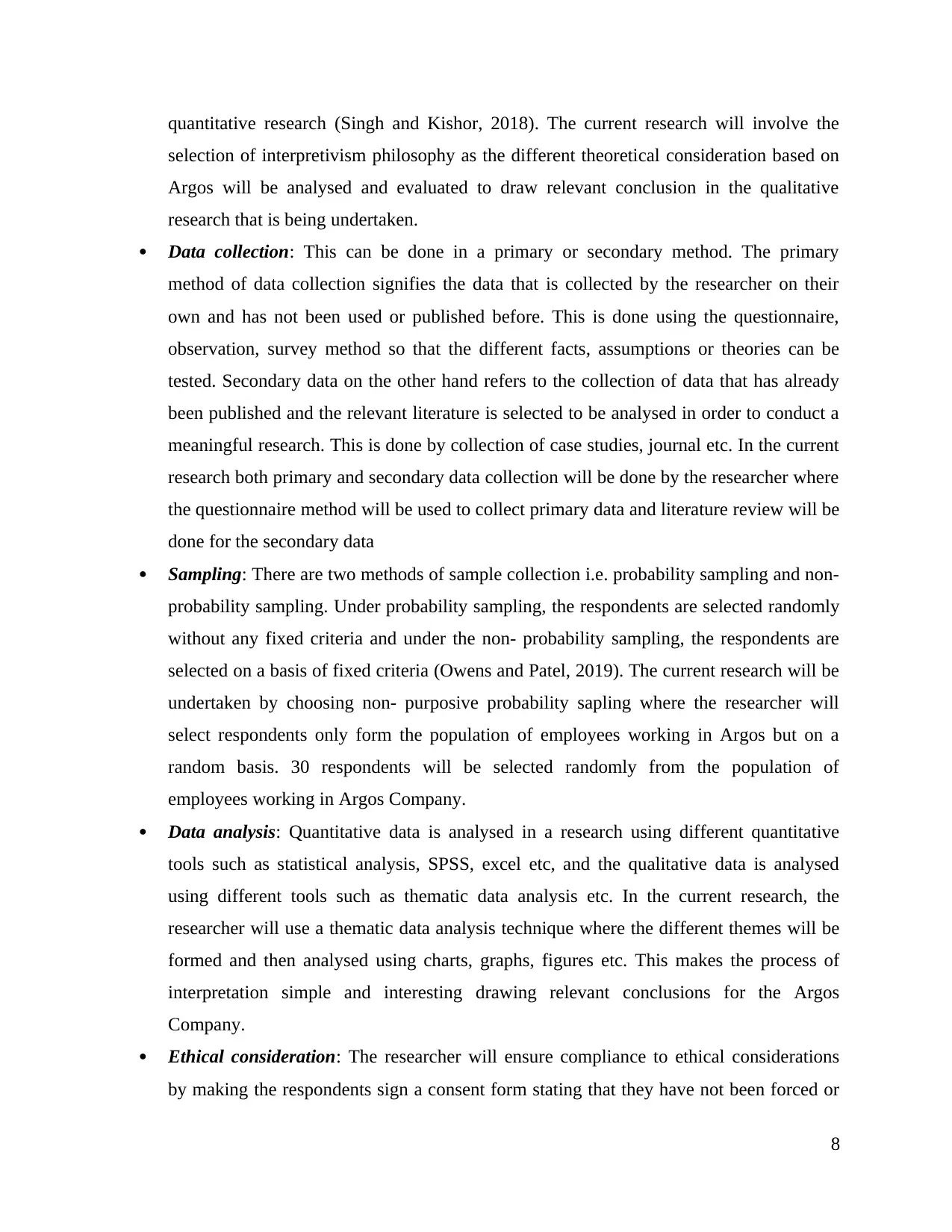
quantitative research (Singh and Kishor, 2018). The current research will involve the
selection of interpretivism philosophy as the different theoretical consideration based on
Argos will be analysed and evaluated to draw relevant conclusion in the qualitative
research that is being undertaken.
Data collection: This can be done in a primary or secondary method. The primary
method of data collection signifies the data that is collected by the researcher on their
own and has not been used or published before. This is done using the questionnaire,
observation, survey method so that the different facts, assumptions or theories can be
tested. Secondary data on the other hand refers to the collection of data that has already
been published and the relevant literature is selected to be analysed in order to conduct a
meaningful research. This is done by collection of case studies, journal etc. In the current
research both primary and secondary data collection will be done by the researcher where
the questionnaire method will be used to collect primary data and literature review will be
done for the secondary data
Sampling: There are two methods of sample collection i.e. probability sampling and non-
probability sampling. Under probability sampling, the respondents are selected randomly
without any fixed criteria and under the non- probability sampling, the respondents are
selected on a basis of fixed criteria (Owens and Patel, 2019). The current research will be
undertaken by choosing non- purposive probability sapling where the researcher will
select respondents only form the population of employees working in Argos but on a
random basis. 30 respondents will be selected randomly from the population of
employees working in Argos Company.
Data analysis: Quantitative data is analysed in a research using different quantitative
tools such as statistical analysis, SPSS, excel etc, and the qualitative data is analysed
using different tools such as thematic data analysis etc. In the current research, the
researcher will use a thematic data analysis technique where the different themes will be
formed and then analysed using charts, graphs, figures etc. This makes the process of
interpretation simple and interesting drawing relevant conclusions for the Argos
Company.
Ethical consideration: The researcher will ensure compliance to ethical considerations
by making the respondents sign a consent form stating that they have not been forced or
8
selection of interpretivism philosophy as the different theoretical consideration based on
Argos will be analysed and evaluated to draw relevant conclusion in the qualitative
research that is being undertaken.
Data collection: This can be done in a primary or secondary method. The primary
method of data collection signifies the data that is collected by the researcher on their
own and has not been used or published before. This is done using the questionnaire,
observation, survey method so that the different facts, assumptions or theories can be
tested. Secondary data on the other hand refers to the collection of data that has already
been published and the relevant literature is selected to be analysed in order to conduct a
meaningful research. This is done by collection of case studies, journal etc. In the current
research both primary and secondary data collection will be done by the researcher where
the questionnaire method will be used to collect primary data and literature review will be
done for the secondary data
Sampling: There are two methods of sample collection i.e. probability sampling and non-
probability sampling. Under probability sampling, the respondents are selected randomly
without any fixed criteria and under the non- probability sampling, the respondents are
selected on a basis of fixed criteria (Owens and Patel, 2019). The current research will be
undertaken by choosing non- purposive probability sapling where the researcher will
select respondents only form the population of employees working in Argos but on a
random basis. 30 respondents will be selected randomly from the population of
employees working in Argos Company.
Data analysis: Quantitative data is analysed in a research using different quantitative
tools such as statistical analysis, SPSS, excel etc, and the qualitative data is analysed
using different tools such as thematic data analysis etc. In the current research, the
researcher will use a thematic data analysis technique where the different themes will be
formed and then analysed using charts, graphs, figures etc. This makes the process of
interpretation simple and interesting drawing relevant conclusions for the Argos
Company.
Ethical consideration: The researcher will ensure compliance to ethical considerations
by making the respondents sign a consent form stating that they have not been forced or
8
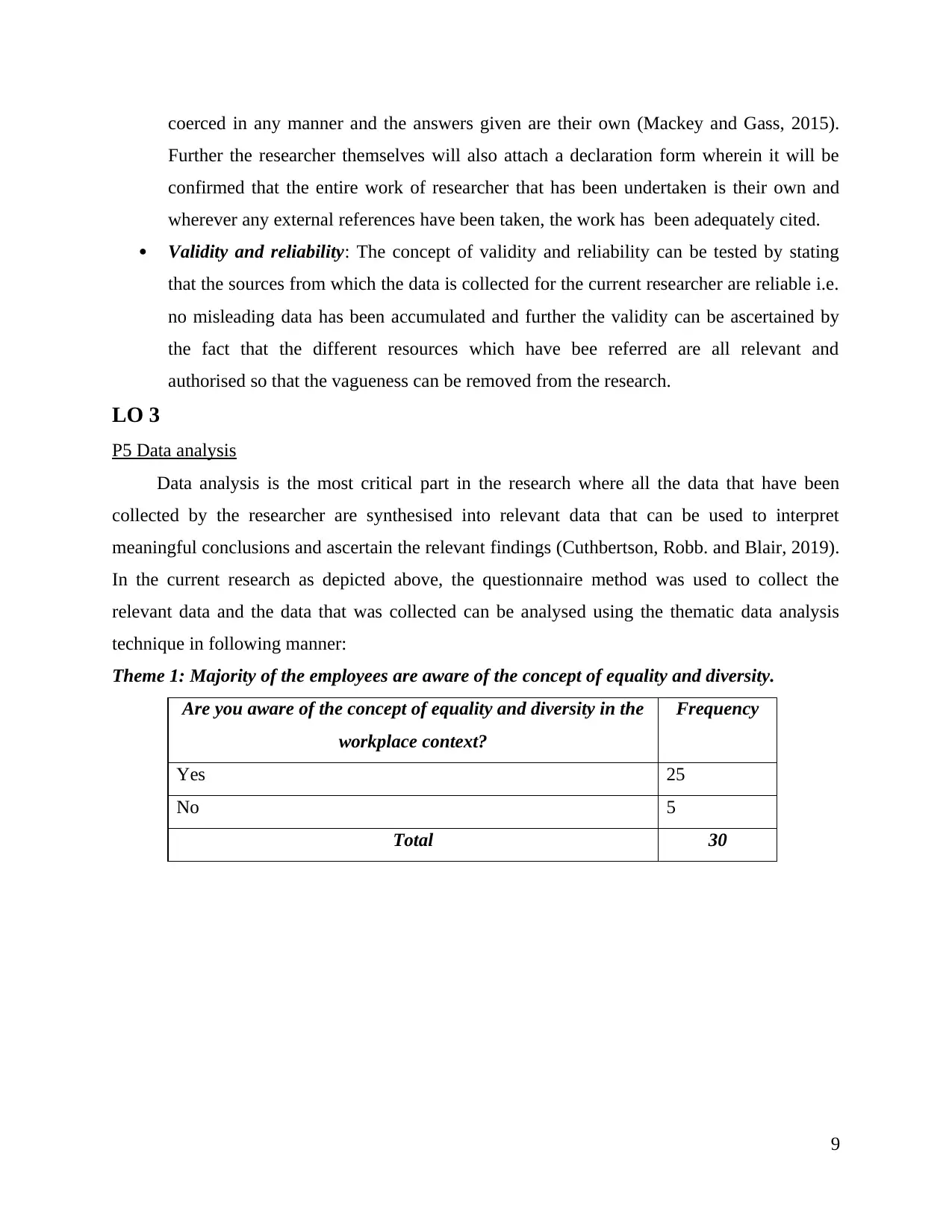
coerced in any manner and the answers given are their own (Mackey and Gass, 2015).
Further the researcher themselves will also attach a declaration form wherein it will be
confirmed that the entire work of researcher that has been undertaken is their own and
wherever any external references have been taken, the work has been adequately cited.
Validity and reliability: The concept of validity and reliability can be tested by stating
that the sources from which the data is collected for the current researcher are reliable i.e.
no misleading data has been accumulated and further the validity can be ascertained by
the fact that the different resources which have bee referred are all relevant and
authorised so that the vagueness can be removed from the research.
LO 3
P5 Data analysis
Data analysis is the most critical part in the research where all the data that have been
collected by the researcher are synthesised into relevant data that can be used to interpret
meaningful conclusions and ascertain the relevant findings (Cuthbertson, Robb. and Blair, 2019).
In the current research as depicted above, the questionnaire method was used to collect the
relevant data and the data that was collected can be analysed using the thematic data analysis
technique in following manner:
Theme 1: Majority of the employees are aware of the concept of equality and diversity.
Are you aware of the concept of equality and diversity in the
workplace context?
Frequency
Yes 25
No 5
Total 30
9
Further the researcher themselves will also attach a declaration form wherein it will be
confirmed that the entire work of researcher that has been undertaken is their own and
wherever any external references have been taken, the work has been adequately cited.
Validity and reliability: The concept of validity and reliability can be tested by stating
that the sources from which the data is collected for the current researcher are reliable i.e.
no misleading data has been accumulated and further the validity can be ascertained by
the fact that the different resources which have bee referred are all relevant and
authorised so that the vagueness can be removed from the research.
LO 3
P5 Data analysis
Data analysis is the most critical part in the research where all the data that have been
collected by the researcher are synthesised into relevant data that can be used to interpret
meaningful conclusions and ascertain the relevant findings (Cuthbertson, Robb. and Blair, 2019).
In the current research as depicted above, the questionnaire method was used to collect the
relevant data and the data that was collected can be analysed using the thematic data analysis
technique in following manner:
Theme 1: Majority of the employees are aware of the concept of equality and diversity.
Are you aware of the concept of equality and diversity in the
workplace context?
Frequency
Yes 25
No 5
Total 30
9
⊘ This is a preview!⊘
Do you want full access?
Subscribe today to unlock all pages.

Trusted by 1+ million students worldwide
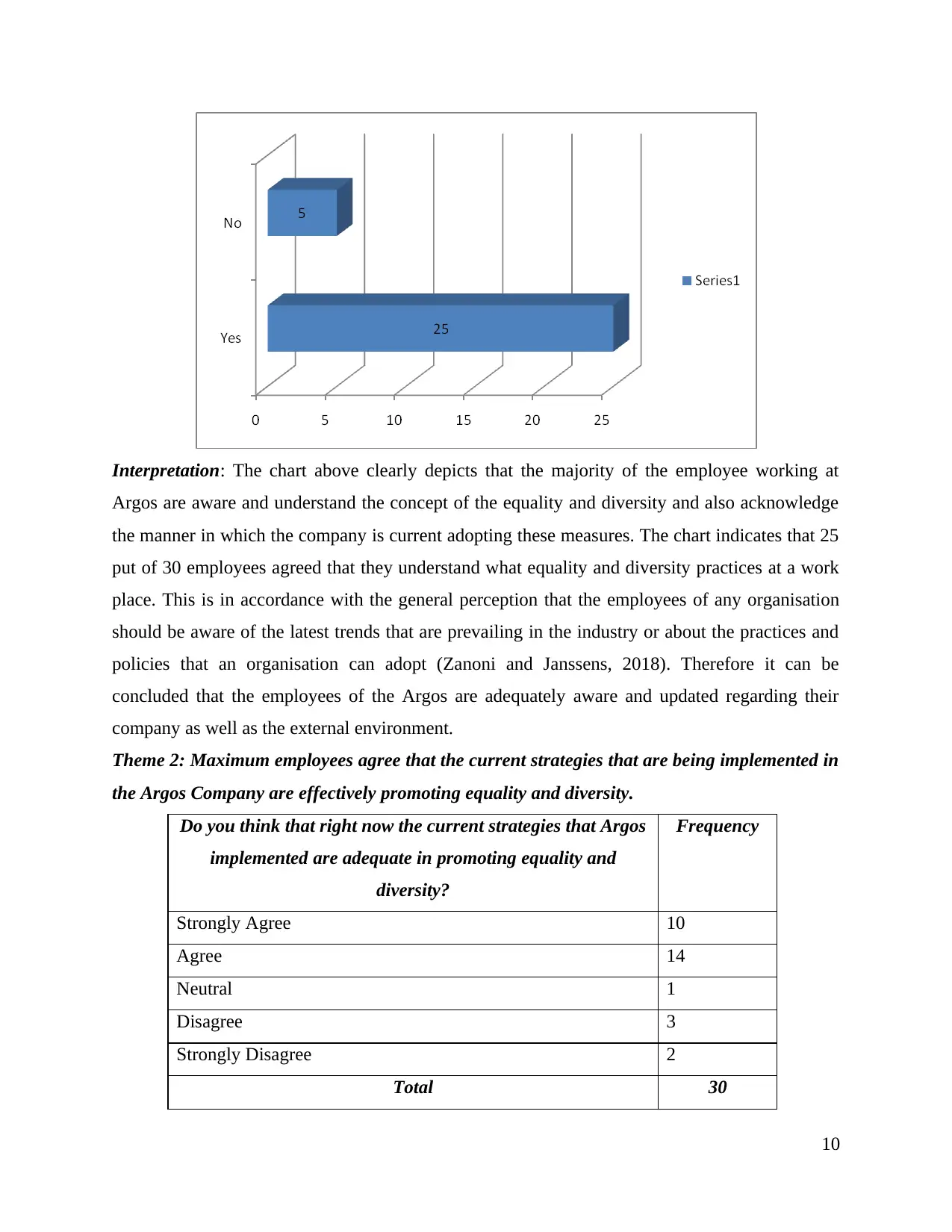
Interpretation: The chart above clearly depicts that the majority of the employee working at
Argos are aware and understand the concept of the equality and diversity and also acknowledge
the manner in which the company is current adopting these measures. The chart indicates that 25
put of 30 employees agreed that they understand what equality and diversity practices at a work
place. This is in accordance with the general perception that the employees of any organisation
should be aware of the latest trends that are prevailing in the industry or about the practices and
policies that an organisation can adopt (Zanoni and Janssens, 2018). Therefore it can be
concluded that the employees of the Argos are adequately aware and updated regarding their
company as well as the external environment.
Theme 2: Maximum employees agree that the current strategies that are being implemented in
the Argos Company are effectively promoting equality and diversity.
Do you think that right now the current strategies that Argos
implemented are adequate in promoting equality and
diversity?
Frequency
Strongly Agree 10
Agree 14
Neutral 1
Disagree 3
Strongly Disagree 2
Total 30
10
Argos are aware and understand the concept of the equality and diversity and also acknowledge
the manner in which the company is current adopting these measures. The chart indicates that 25
put of 30 employees agreed that they understand what equality and diversity practices at a work
place. This is in accordance with the general perception that the employees of any organisation
should be aware of the latest trends that are prevailing in the industry or about the practices and
policies that an organisation can adopt (Zanoni and Janssens, 2018). Therefore it can be
concluded that the employees of the Argos are adequately aware and updated regarding their
company as well as the external environment.
Theme 2: Maximum employees agree that the current strategies that are being implemented in
the Argos Company are effectively promoting equality and diversity.
Do you think that right now the current strategies that Argos
implemented are adequate in promoting equality and
diversity?
Frequency
Strongly Agree 10
Agree 14
Neutral 1
Disagree 3
Strongly Disagree 2
Total 30
10
Paraphrase This Document
Need a fresh take? Get an instant paraphrase of this document with our AI Paraphraser
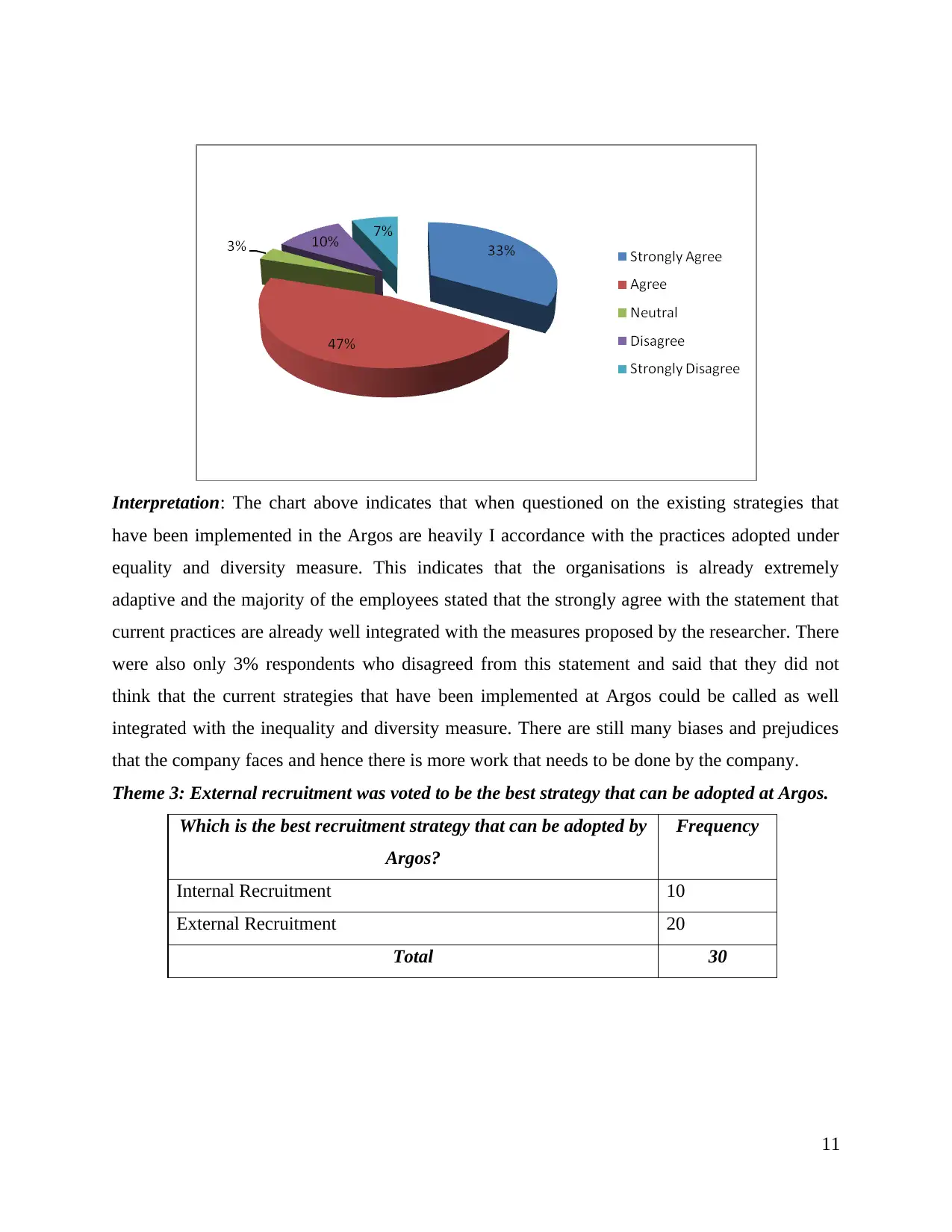
Interpretation: The chart above indicates that when questioned on the existing strategies that
have been implemented in the Argos are heavily I accordance with the practices adopted under
equality and diversity measure. This indicates that the organisations is already extremely
adaptive and the majority of the employees stated that the strongly agree with the statement that
current practices are already well integrated with the measures proposed by the researcher. There
were also only 3% respondents who disagreed from this statement and said that they did not
think that the current strategies that have been implemented at Argos could be called as well
integrated with the inequality and diversity measure. There are still many biases and prejudices
that the company faces and hence there is more work that needs to be done by the company.
Theme 3: External recruitment was voted to be the best strategy that can be adopted at Argos.
Which is the best recruitment strategy that can be adopted by
Argos?
Frequency
Internal Recruitment 10
External Recruitment 20
Total 30
11
have been implemented in the Argos are heavily I accordance with the practices adopted under
equality and diversity measure. This indicates that the organisations is already extremely
adaptive and the majority of the employees stated that the strongly agree with the statement that
current practices are already well integrated with the measures proposed by the researcher. There
were also only 3% respondents who disagreed from this statement and said that they did not
think that the current strategies that have been implemented at Argos could be called as well
integrated with the inequality and diversity measure. There are still many biases and prejudices
that the company faces and hence there is more work that needs to be done by the company.
Theme 3: External recruitment was voted to be the best strategy that can be adopted at Argos.
Which is the best recruitment strategy that can be adopted by
Argos?
Frequency
Internal Recruitment 10
External Recruitment 20
Total 30
11
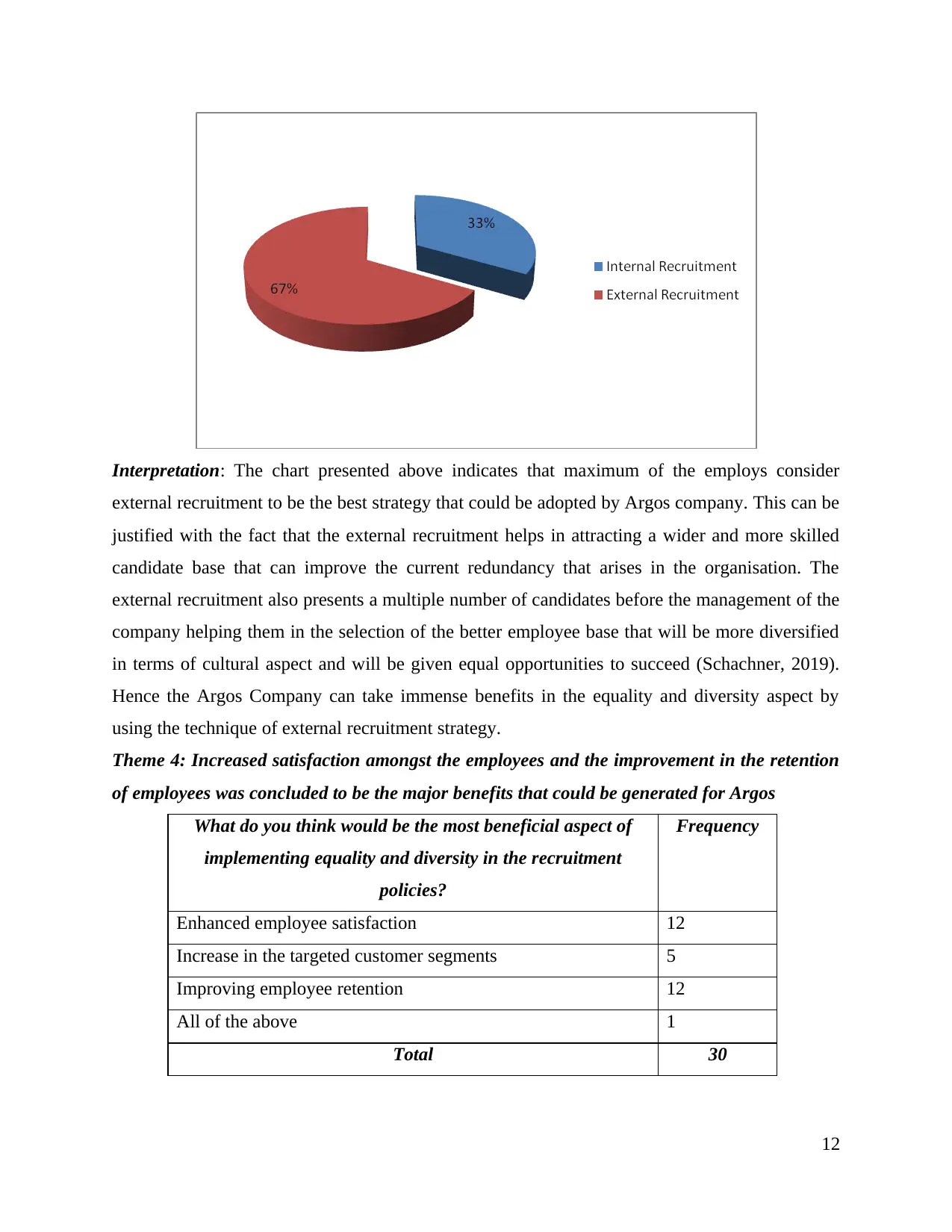
Interpretation: The chart presented above indicates that maximum of the employs consider
external recruitment to be the best strategy that could be adopted by Argos company. This can be
justified with the fact that the external recruitment helps in attracting a wider and more skilled
candidate base that can improve the current redundancy that arises in the organisation. The
external recruitment also presents a multiple number of candidates before the management of the
company helping them in the selection of the better employee base that will be more diversified
in terms of cultural aspect and will be given equal opportunities to succeed (Schachner, 2019).
Hence the Argos Company can take immense benefits in the equality and diversity aspect by
using the technique of external recruitment strategy.
Theme 4: Increased satisfaction amongst the employees and the improvement in the retention
of employees was concluded to be the major benefits that could be generated for Argos
What do you think would be the most beneficial aspect of
implementing equality and diversity in the recruitment
policies?
Frequency
Enhanced employee satisfaction 12
Increase in the targeted customer segments 5
Improving employee retention 12
All of the above 1
Total 30
12
external recruitment to be the best strategy that could be adopted by Argos company. This can be
justified with the fact that the external recruitment helps in attracting a wider and more skilled
candidate base that can improve the current redundancy that arises in the organisation. The
external recruitment also presents a multiple number of candidates before the management of the
company helping them in the selection of the better employee base that will be more diversified
in terms of cultural aspect and will be given equal opportunities to succeed (Schachner, 2019).
Hence the Argos Company can take immense benefits in the equality and diversity aspect by
using the technique of external recruitment strategy.
Theme 4: Increased satisfaction amongst the employees and the improvement in the retention
of employees was concluded to be the major benefits that could be generated for Argos
What do you think would be the most beneficial aspect of
implementing equality and diversity in the recruitment
policies?
Frequency
Enhanced employee satisfaction 12
Increase in the targeted customer segments 5
Improving employee retention 12
All of the above 1
Total 30
12
⊘ This is a preview!⊘
Do you want full access?
Subscribe today to unlock all pages.

Trusted by 1+ million students worldwide
1 out of 20
Related Documents
Your All-in-One AI-Powered Toolkit for Academic Success.
+13062052269
info@desklib.com
Available 24*7 on WhatsApp / Email
![[object Object]](/_next/static/media/star-bottom.7253800d.svg)
Unlock your academic potential
Copyright © 2020–2025 A2Z Services. All Rights Reserved. Developed and managed by ZUCOL.





